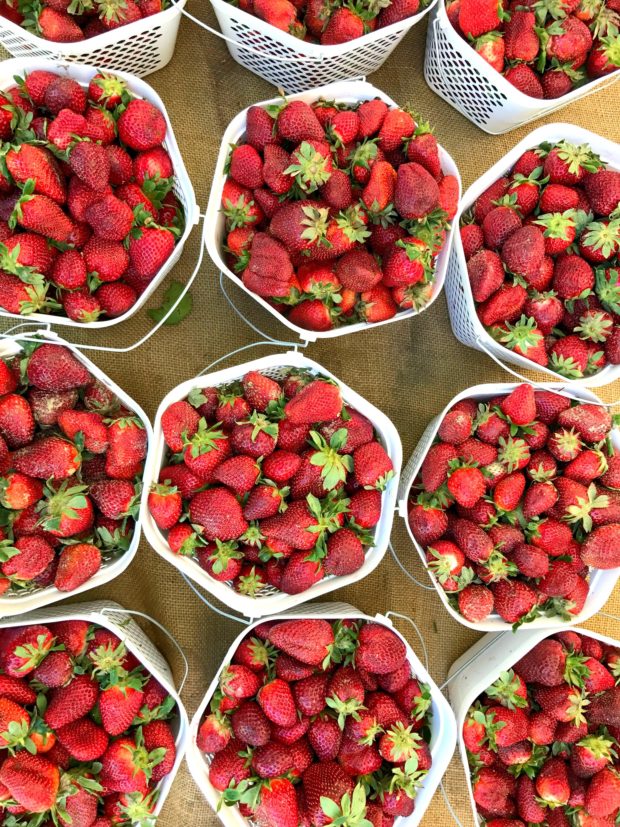Organic food can be affordable, if you shop strategically and plan ahead using these nine tips.
Buying organic doesn’t just reduce your family’s exposure to toxic chemicals, promote more humane treatment of animals, and deliver higher earnings to farmers, it also helps protect the environment. With Earth Day approaching, I’ve been thinking about all these variables a lot lately.
As we’ve all noticed, organic food and products do cost more. This higher price point is partly because of limited supply (only 1% of farmland in the U.S. is organic) and partly because organic farming practices are just more costly. Yet buying organic – at least some of the time – is more doable than people think.
As a blogger, married to a teacher, with two young kids and a life in an expensive part of the country, I’ve learned to bargain hunt. Good food is a priority for us, but we do have a budget and are able to stick to it despite buying almost everything organic.
Below are my tips for buying organic, affordably.
9 Ways to Make Organic Food More Affordable
- Be flexible on the brands you buy. Like everyone I have my favorite products, but if I only bought those brands every week, I’d go broke. Buy whatever organic yogurt, milk, meat, produce, snacks are on sale and you’ll save a bundle. You may also find new favorite products you otherwise wouldn’t have tried.
- Plan around what’s on sale. If I’m planning to roast asparagus for dinner but it’s $4/lb and the green beans are on sale for $1.50/lb, I’m getting the green beans. If nothing appealing is on sale, I head to the frozen aisle.
- Shop at Trader Joe’s. The packaging waste at Trader Joe’s kills me, but it’s a great place to find affordable organic food. Keep excess waste down by bringing your reusable grocery and produce bags, and buy their loose produce instead of pre-packaged whenever possible.
- Use plenty of frozen veggies. You can usually get a whole bag of organic broccoli florets, cauliflower, green beans, peas and more – even at Whole foods – for around $2.
- Create meals around beans. Dry beans are inexpensive and give you a ton of bang for your buck. I make a batch every week, to use in soup (1-2 meals), sprinkle on salad (1 meal), add to quesadillas (1 meal) and turn into veggie dip (3-4 snacks). This is a great way to get protein, affordably.
- Use meat as an “accent” ingredient. No need to go vegetarian if your family likes meat. But beginning to use meat as a “side dish” and plant-based foods as the main event will not only save you money but also improve your health. (e.g. sprinkle two crispy bacon slices on top of a corn and potato chowder, serve veggie-packed pasta with a few sausage slices on top, and make chili with 1/3 lb ground beef + lots of beans instead of mostly meat).
- Don’t “stock up.” This may seem counterintuitive, but buying a lot of something when it’s on sale is more likely to lead to food waste than cost savings. Instead, keep your pantry and freezer stashes relatively light so you can easily see what you have and what you truly need to buy.
- Meal plan, to avoid food waste. Plan a couple dinners, lunches and snacks then head to the store armed with a (flexible) list. If one recipe you planned on calls for parsley, but the others don’t, just skip it. No need to spend money on something you’ll end up wasting most of – when the recipe will taste good regardless.
- Shop more than once a week. Instead of doing a huge shopping trip every week, split the trip into 2-3 outings and plan for fewer days. You’ll waste less, be more efficient with what you have, and may even find you have plenty in the pantry/freezer/fridge to get by for longer than you think.
I’d love to hear your own tips too!







3 Comments
David Brown
April 13, 2017 at 6:40 am6. Use meat as an “accent” ingredient.
That is really good advice. Our modernized, industrialized agricultural system often furnishes consumers with meat that contains excessive omega-6 arachidonic acid. Moreover, meat is often deficient in the the omega-3 family of fatty acids. Excerpt from a British Medical Journal editorial entitled “The importance of a balanced ω-6 to ω-3 ratio in the prevention and management of obesity”.
“We now know that major changes have taken place in the food supply over the last 100 years, when food technology and modern agriculture led to enormous production of vegetable oils high in ω-6 fatty acids, and changed animal feeds from grass to grains, thus increasing the amount of ω-6 fatty acids at the level of LA (from oils) and arachidonic acid (AA) (from meat, eggs, dairy). This led to very high amounts of ω-6 fatty acids in the food supply for the first time in the history of human beings.”
http://openheart.bmj.com/content/3/2/e000385
All meat, including that of mammals, birds, fish, and crustaceans, has an essential fatty acid profile that reflects the fatty acid profile of what the creatures eat. Grain-fed meats are pro-inflammatory. Meat from pastured animals and animals harvested from the wild is not. Abstract from a research paper by Iranian scientists. Note that for them, English would be a second language.
“The aim of this study is comparison of fatty acid profile between wild and farmed Indian white shrimps. According to the score-plot produced by the principle component analysis the wild Indian white shrimp showed a fatty acid composition clearly different from the farmed Indian white shrimp. In both groups, palmitic acid (16:0) and oleic acid (18: 1n-9) were the main SFA and MUFA, respectively. Based on results, the wild shrimp contained a higher level of n-3 poly unsaturated fatty acids, whereas farmed shrimp contained a high level of n-6 poly unsaturated fatty. Arachidonic acid (20: 4n-6), eicosapentaenoic acid (20: 5n-3) and docosahexaenoic acid (22: 6n-3) were significantly higher in wild shrimps. The n-3/n-6 fatty acids ratio was significantly higher in wild shrimps. The comparison demonstrated that the nutritional value of wild shrimps is better than farmed shrimp and fatty acid profile of commercial diets should be reformed in order to maintenance of farmed shrimps nutritional value.” http://file.scirp.org/pdf/FNS20110800003_99567716.pdf
As for other livestock, this is what scientists have learned.
“Arachidonic acid (AA) in the diet can be efficiently absorbed and incorporated into tissue membranes, resulting in an increased production of thromboxane A2 by platelets and increased ex vivo platelet aggregability. Results from previous studies have shown that AA is concentrated in the membrane phospholipids of lean meats.” https://www.ncbi.nlm.nih.gov/pubmed/9590632
“The highest level of AA in lean meat was in duck (99 mg/100 g), whereas pork fat had the highest concentration for the visible fats (180 mg/100 g). The lean portions of beef and lamb contained the higher levels of n-3 polyunsaturated fatty acids (PUFA) compared with white meats which were high in AA and low in n-3 PUFA. The present data indicate that the visible meat fat can make a contribution to dietary intake of AA, particularly for consumers with high intakes of fat from pork or poultry meat.” https://www.ncbi.nlm.nih.gov/pubmed/9590632
This is an excellent blog. I especially like your 7 WAYS I’VE KEPT WEIGHT OFF FOR GOOD post. Keep up the good work.
Amelia Winslow
April 13, 2017 at 10:53 amHi David, thanks for your thoughtful comment and for providing science-based links for people to learn more if they’re curious. I appreciate you reading and taking the time to share your thoughts.
sanamamit
October 17, 2017 at 4:47 amthanks for sharing great steps.